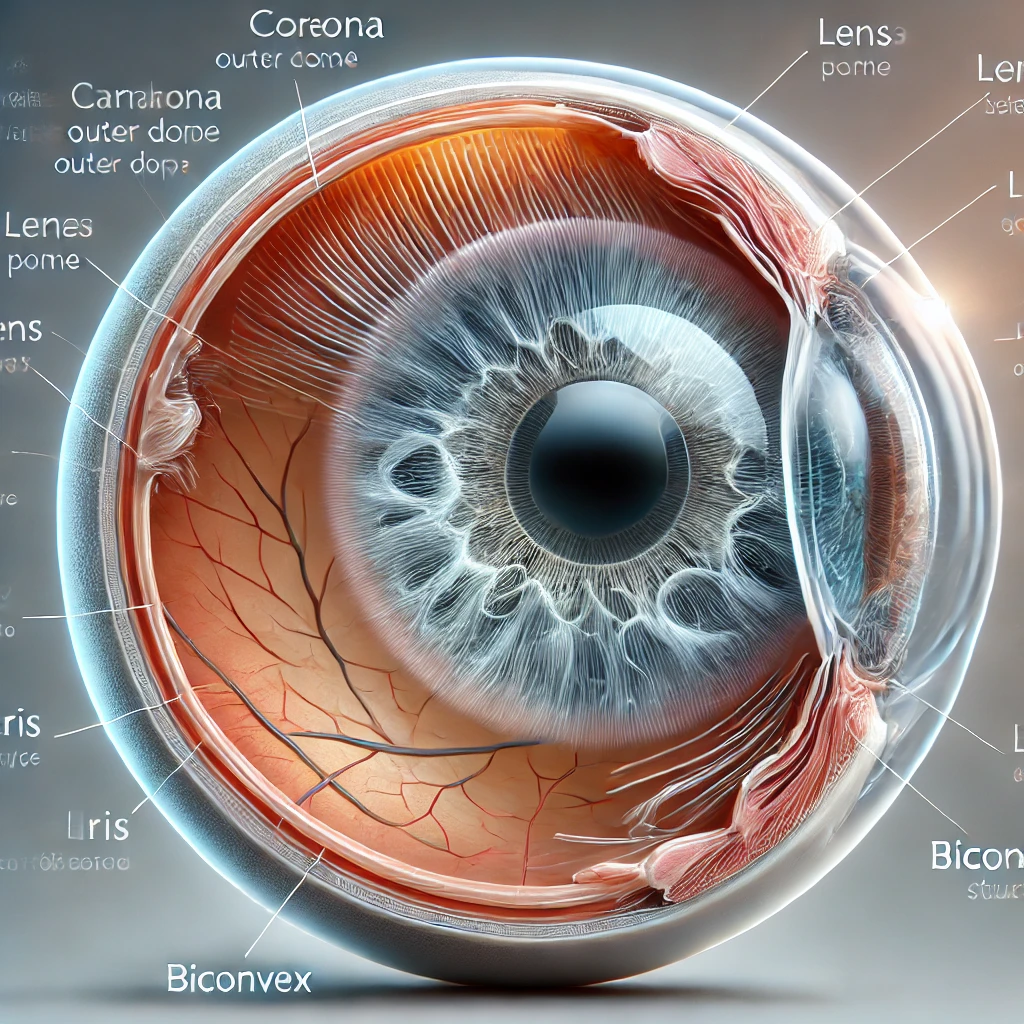The Cornea And Lense
At a Glance: The Cornea and Lense
Function: Focuses light on the retina for clear vision.
Diagnosis: Comprehensive eye exam, including slit-lamp and refraction tests.
Treatment: Eyeglasses, contact lenses, LASIK, corneal transplants, or cataract surgery.

The Cornea and Lense
The cornea and lens are two vital components of the human eye, working together to ensure clear vision. They play distinct yet complementary roles in focusing light onto the retina, where visual signals are processed and sent to the brain. In this detailed explanation, we’ll explore the anatomy, function, common issues, and care tips for these fascinating structures
The cornea and lens act as the dynamic optical team responsible for focusing light onto the retina. The cornea is the eye’s outermost layer, serving as a protective barrier and refracting light.
Meanwhile, the lens sits behind the pupil and fine-tunes the focus for objects at varying distances. Without these two structures, our ability to perceive a clear image would be compromised.
Anatomy of the Cornea:
The cornea is a clear, dome-shaped structure that covers the front of the eye. It consists of five layers, each with a specific function:
- Epithelium: The outermost layer, providing protection and absorbing oxygen and nutrients.
- Bowman’s Layer: A tough, protective barrier beneath the epithelium.
- Stroma: The thickest layer, responsible for maintaining the cornea’s shape.
- Descemet’s Membrane: A thin, elastic layer that supports the endothelium.
- Endothelium: Regulates fluid levels to keep the cornea clear.
Anatomy of the Lens
The lens is a biconvex, transparent structure located directly behind the iris. Made primarily of proteins and water, it is flexible and capable of changing shape to focus light on the retina.
This process, known as accommodation, allows us to see objects at varying distances. The lens is held in place by zonules (tiny fibers) attached to the ciliary body, which adjusts its shape as needed

The Cornea and Lens: A Collaborative Duo
The cornea and lens work in harmony to focus light accurately. The cornea provides the majority of the eye’s refractive power, bending incoming light rays.
The lens then refines this focus, ensuring a sharp image lands on the retina. Together, they create a seamless visual experience, allowing us to see the world with clarity
The Cornea: Protecting and Enhancing Vision
Beyond its role in vision, the cornea acts as a shield, protecting the eye from dust, germs, and harmful UV rays. It also plays a critical role in maintaining the eye’s structural integrity. Its smooth, curved surface is essential for refracting light properly, enhancing the overall quality of vision.
The Lens: Master of Accommodation
The lens is crucial for adapting to our visual needs. Whether reading a book or gazing at a distant mountain, the lens changes its curvature to adjust focus.
This ability diminishes with age, leading to presbyopia—a condition where near vision becomes challenging. Despite this, the lens remains indispensable for clear and focused sight throughout life.
Common Disorders of the Cornea and Lens
Several conditions can affect the cornea and lens, impairing vision:
- Keratoconus: A progressive thinning of the cornea, causing it to bulge into a cone shape.
- Cataracts: Clouding of the lens, often age-related, leading to blurry vision.
- Corneal Ulcers: Painful sores on the cornea, usually caused by infection.
- Fuchs’ Dystrophy: A condition where the corneal endothelium deteriorates, causing swelling and vision loss.
The Cornea and Lens in Aging Eyes
As we age, the cornea and lens undergo natural changes. The lens becomes less flexible, leading to presbyopia, while the risk of cataracts increases.
Similarly, the cornea may develop arcus senilis—a gray or white ring around its edge. These changes, while common, can impact visual quality, making regular eye exams essential.

Advancements in Corneal and Lens Surgery
Modern medicine offers numerous surgical solutions for corneal and lens disorders:
- LASIK: Reshapes the cornea to correct refractive errors like myopia or hyperopia.
- Corneal Transplants: Replaces damaged corneas with donor tissue.
- Cataract Surgery: Removes the cloudy lens and replaces it with an artificial one.
These advancements have significantly improved outcomes for individuals with vision impairments
Caring for the Cornea and Lens:
Maintaining the health of the cornea and lens is crucial for lifelong clear vision. Here’s how you can care for them:
- Wear sunglasses to protect against UV damage.
- Avoid rubbing your eyes to prevent corneal injury.
- Maintain proper hygiene with contact lenses.
- Eat a balanced diet rich in antioxidants and omega-3 fatty acids.
- Schedule regular eye exams to monitor and address any issues early.

